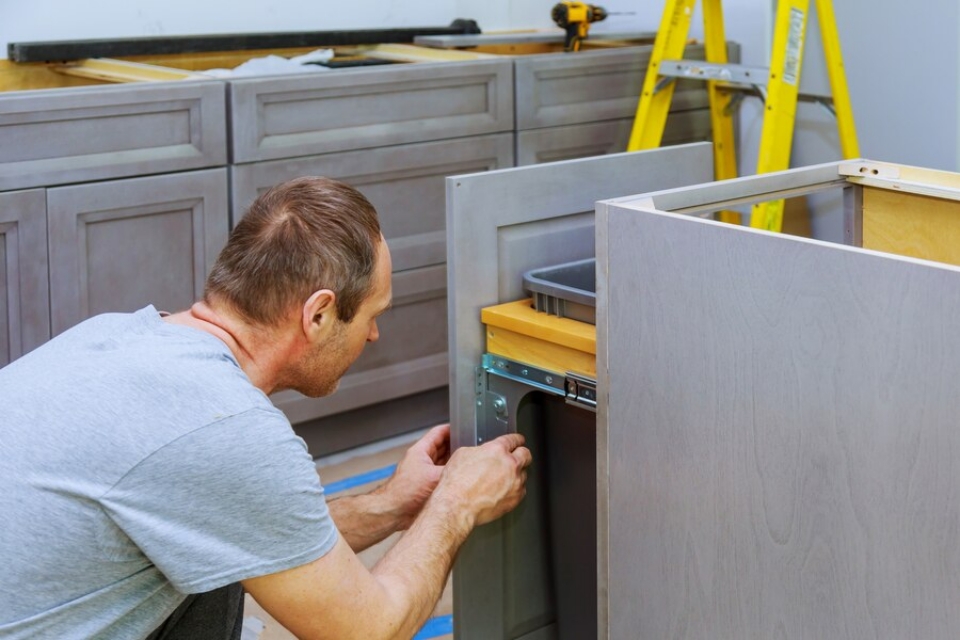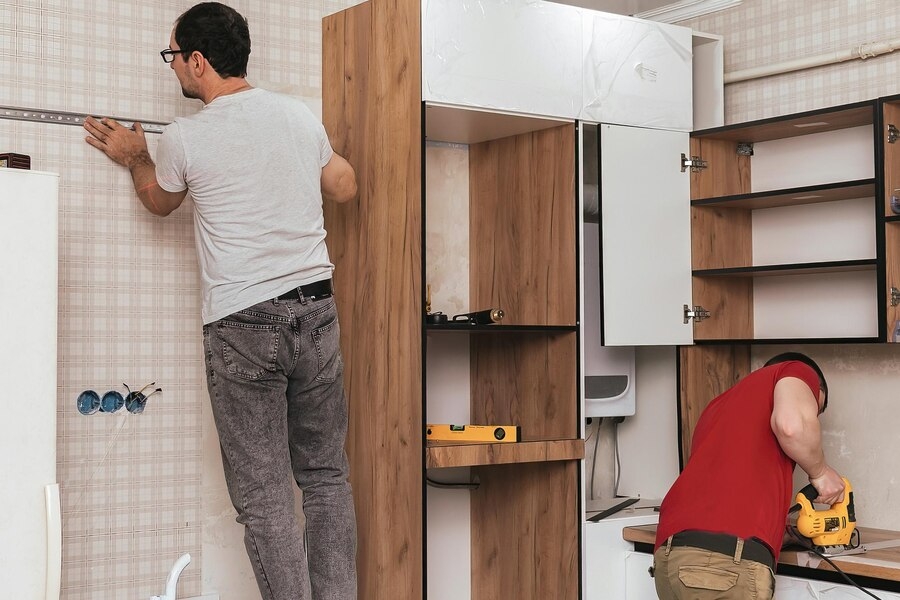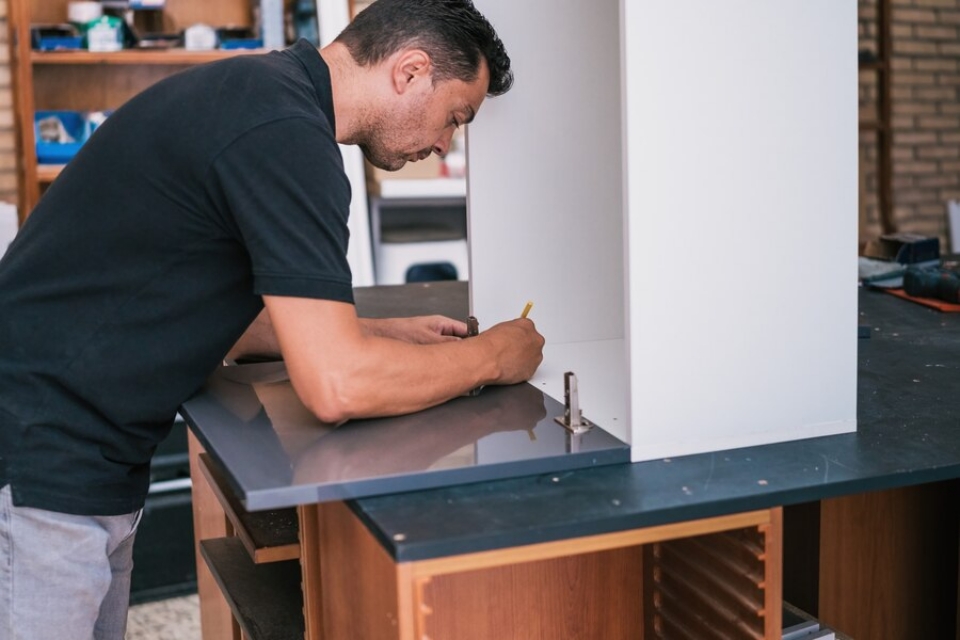Renovating a kitchen can be a thrilling yet daunting task, especially when it comes to installing kitchen cabinets. The time it takes to install kitchen cabinets depends on various factors such as the type of cabinets, the complexity of the design, and the skill level of the installer. In this article, we will delve into the different aspects that influence the duration of a kitchen cabinet installation project, providing you with a comprehensive guide to help you plan accordingly. Normally, as an individual, kitchen cabinet installations can take 2-3 Days depending upon the size of your house and the customizations you do. The Efforts you put into this work can also influence the time taken.
Key Takeaways
- The type of kitchen cabinets (stock, semi-custom, custom) influences installation time.
- The complexity of the kitchen design and pre-installation preparation are critical factors.
- Professional installers can expedite the process compared to DIY efforts.
- Proper preparation, accurate measurements, and addressing potential challenges can ensure a successful installation.
Factors Affecting Kitchen Cabinet Installation Time
Several elements can impact the time required to install kitchen cabinets. Understanding these factors will help you set realistic expectations and prepare better for the project.
1. Type of Kitchen Cabinets
The type of kitchen cabinets you choose can significantly affect the installation timeline. Stock cabinets, which are pre-manufactured and readily available, typically take less time to install compared to custom or semi-custom cabinets. Custom cabinets are made to order and require precise measurements and detailed craftsmanship, resulting in a longer installation process.

2. Complexity of Design in Kitchen Cabinets
The complexity of your kitchen cabinet design plays a crucial role in the installation time. A simple, straightforward layout with standard-sized cabinets will be quicker to install than a complex design with unique configurations, corner cabinets, or specialized features like pull-out shelves and soft-close drawers.
3. Pre-Installation Preparation
Proper preparation is key to a smooth and efficient installation. This includes tasks such as removing old cabinets, ensuring the walls and floors are level, and making any necessary adjustments to plumbing and electrical systems. Skipping or inadequately performing these steps can lead to delays and complications during the installation process.
4. Skill Level of the Installer
The installer’s experience and expertise can greatly influence the project’s duration. Professional installers with years of experience can complete the installation more quickly and efficiently than DIY enthusiasts or less experienced contractors.
Step-by-Step Installation Process
To give you a clearer picture of the time involved, let’s break down the typical steps in a kitchen cabinet installation project.
1. Preparation and Planning
Before the actual installation begins, thorough preparation and planning are essential. This stage includes measuring the kitchen space, ordering the cabinets, and ensuring all necessary tools and materials are available. Depending on the availability of cabinets and materials, this phase can take anywhere from a few days to several weeks.
2. Demolition and Removal
If you are replacing existing cabinets, the first step is to remove the old ones. This process involves disconnecting plumbing and electrical connections, carefully removing the cabinets, and disposing of them properly. Demolition can take a day or two, depending on the size of your kitchen and the complexity of the existing setup.
3. Wall and Floor Preparation
Once the old cabinets are removed, the walls and floors need to be prepared for the new installation. This includes patching any holes, leveling surfaces, and making any necessary adjustments to plumbing and electrical systems. This step can take a couple of days to a week, depending on the condition of your kitchen.
4. Assembling the Kitchen Cabinets
If you have chosen flat-pack or ready-to-assemble cabinets, you will need to spend time putting them together before installation. Assembling cabinets can take anywhere from a few hours to a full day, depending on the number of cabinets and the complexity of the assembly process.

5. Installing the Kitchen Cabinets
The actual installation of the kitchen cabinets is a multi-step process that requires precision and attention to detail.
- Hanging Upper Cabinets: The installation typically begins with the upper cabinets. They are hung on the wall using a level to ensure they are straight and aligned. This step can take several hours to a full day, depending on the number of cabinets and the difficulty of the layout.
- Installing Base Cabinets: Next, the base cabinets are installed. They need to be leveled and secured to the wall and floor. This process can also take a day or more, depending on the number of cabinets and any adjustments needed for plumbing or electrical outlets.
- Attaching Cabinet Doors and Hardware: After the cabinets are securely in place, the doors, drawers, and hardware are attached. This step involves installing hinges, handles, and knobs, which can take a few hours to a full day, depending on the number of cabinets and the intricacy of the hardware.
6. Finishing Touches
The final step in the installation process includes adding finishing touches such as trim, molding, and caulking. This stage ensures that the cabinets look seamless and polished. Finishing touches can take an additional day or two to complete.
Estimated Time for Kitchen Cabinets Installation
Based on the factors and steps outlined above, here are some estimated timeframes for kitchen cabinet installation:
- Stock Cabinets: 1 to 3 days
- Semi-Custom Cabinets: 3 to 5 days
- Custom Cabinets: 1 to 2 weeks
Challenges in Kitchen Cabinet Installation and How to Overcome Them

1. Measurement Errors
One of the most common issues during cabinet installation is measurement errors. Accurate measurements are crucial for a seamless fit. Double-checking measurements and using precise tools can help avoid this problem.
2. Leveling Issues
Uneven walls and floors can cause leveling issues during installation. Using shims and a level can help address these problems, ensuring that the cabinets are installed correctly.
3. Delays in Delivery
Delays in the delivery of cabinets and materials can stall the installation process. To mitigate this, order your cabinets well in advance and confirm delivery dates with the supplier.
Tips for Smooth Kitchen Cabinets Installation Process
- Plan Ahead: Thorough planning can save time and prevent issues during installation.
- Hire Professionals: Experienced installers can complete the job more quickly and efficiently.
- Prepare the Space: Ensure the kitchen is ready for installation, with walls and floors properly prepared.
- Have All Materials Ready: Gather all necessary tools and materials before starting the project.
- Double-Check Measurements: Accurate measurements are critical for a successful installation.
Frequently Asked Questions (FAQs)
1. How long does it take to install stock kitchen cabinets?
Stock cabinets typically take 1 to 3 days to install, depending on the kitchen size and layout.
2. What factors can delay the installation of kitchen cabinets?
Delays can be caused by inaccurate measurements, leveling issues, and delays in the delivery of cabinets and materials.
3. Can I install kitchen cabinets myself?
Yes, you can install kitchen cabinets yourself, but it requires careful planning, precise measurements, and the right tools. Hiring a professional can ensure a quicker and more efficient installation.
4. How do I prepare my kitchen for cabinet installation?
Preparation involves removing old cabinets, ensuring walls and floors are level, and making any necessary adjustments to plumbing and electrical systems.
5. What are the benefits of hiring a professional installer?
Professional installers bring experience, expertise, and efficiency to the project, often completing the installation more quickly and with fewer errors.
6. How much time should I allocate for a custom kitchen cabinet installation?
Custom cabinet installations can take 1 to 2 weeks, depending on the complexity of the design and the preparation required.
7. What are common challenges during kitchen cabinet installation?
Common challenges include measurement errors, leveling issues, and delays in delivery. Planning and using precise tools can help overcome these challenges.
Conclusion
Installing kitchen cabinets is a significant undertaking that requires careful planning and execution. The time it takes to complete the installation depends on various factors, including the type of cabinets, the complexity of the design, and the skill level of the installer. By understanding these factors and following the steps outlined in this guide, you can ensure a smooth and efficient kitchen cabinet installation process.

